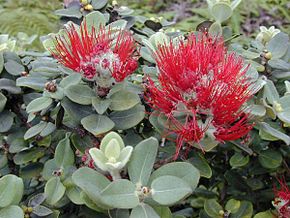 |
| Ohia Lehua (Public Domain) |
tells us that people the world over have decorated with
leis since ancient times.
However, the practice uniquely
developed in Hawaii because of its traditional isolation,
and because of its "abundance of blossoms, beads, and
leaves."
Leis began being associated with life's profound moments early on. Schweitzer
tells us that there "are leis for political, community, social, personal, farming, and religious
ceremony." She explains that these ceremonies tended to overlap in old Hawaii, and that they "all belonged to a people united
by a deep-rooted belief in their gods."
Two such deities are the goddesses Pele and her sister Hi'iaka. They are honored by the lehua flower (ohia lehua), which is described as "the tragic fire flower" of these
sisters. Sacred Texts tells us
that Pele was expelled from her original home and wandered from island to island seeking shelter for her family. Having fallen
deeply in love with a chief of Kauai, she chose a crater on Hawaii, and settled there along with her brothers and little sister Hi'iaka.
Ever the fiery spirit, Pele then sent Hi'iaka to fetch the
chief and bring him back to her.
Her passion became a burning jealousy when Hi'iaka betrayed Pele by romancing the
chief. Schweitzer now warns: Even today, one shouldn't pick the lehua flower on the way to
the volcano, Pele's home. The
results could be disastrous…
The maile leaf lei has been particularly associated with the gods of hula. Maile is
said to have "many siblings, with different shaped leaves and traditions." Hawaiian legend tells us that there was "a greedy maile, a brittle
maile, a luxuriant maile, and a sweetly scented maile." When they weren't able to assist their demi-god brother in his ardent pursuit of a chiefess, he abandoned them within the forest.
Resources
http://www.coffeetimes.com/leis.htm
http://www.sacred-texts.com/pac/hm/hm13.htm
Copyright May 1, 2013 by Linda Van Slyke All Rights Reserved
No comments:
Post a Comment